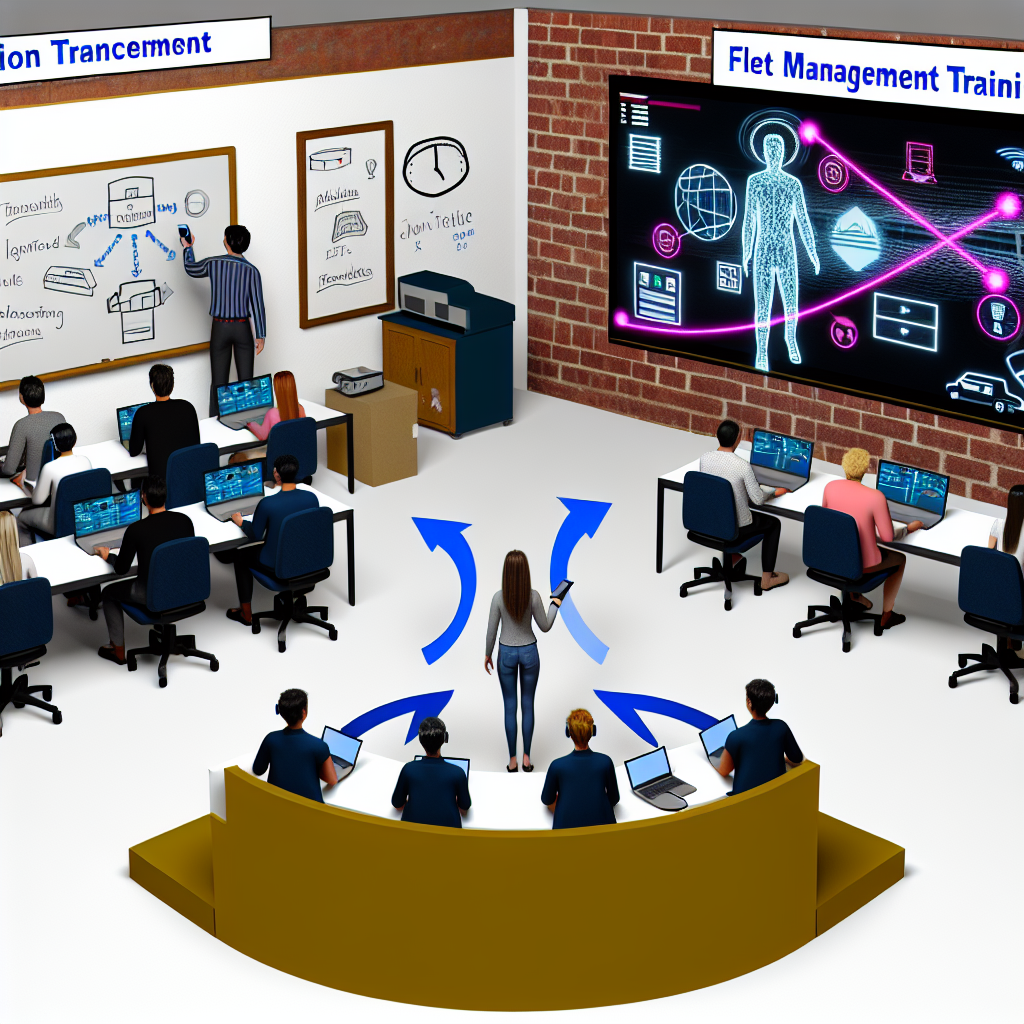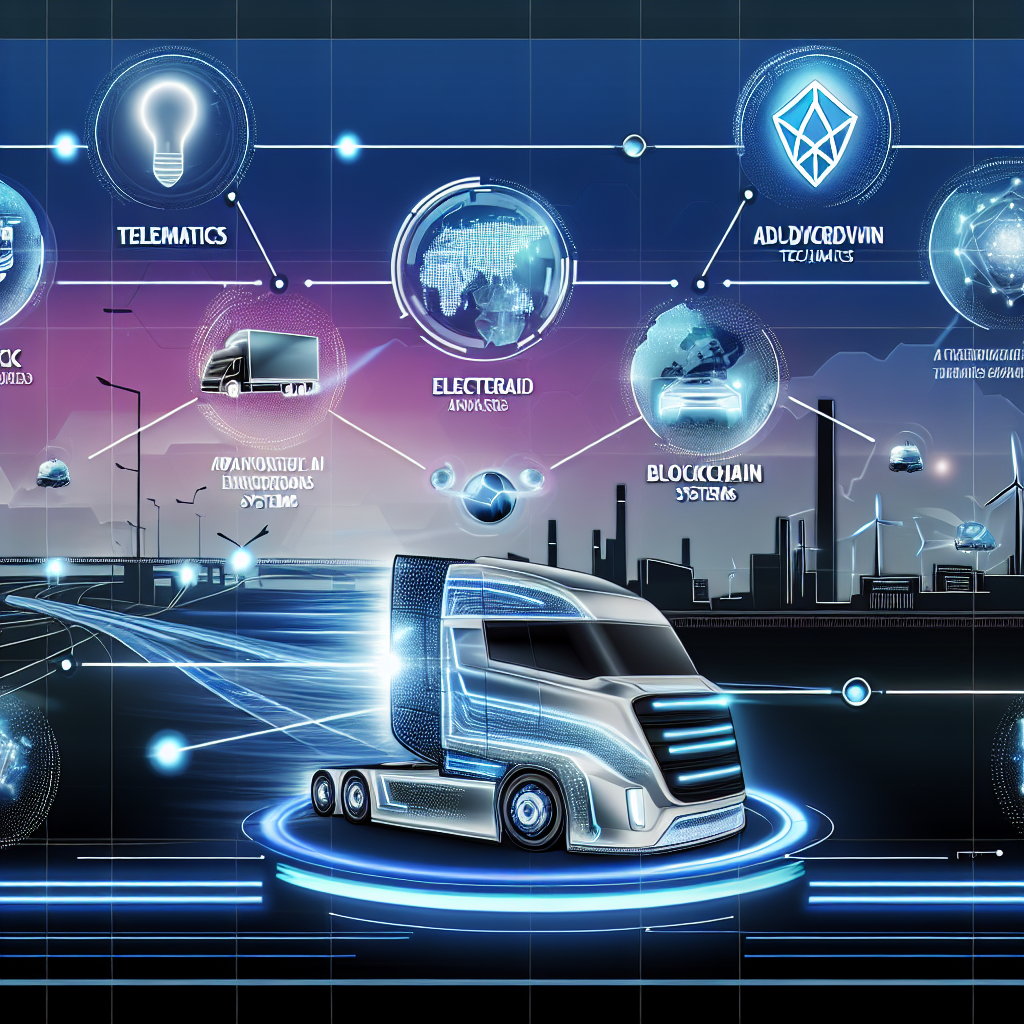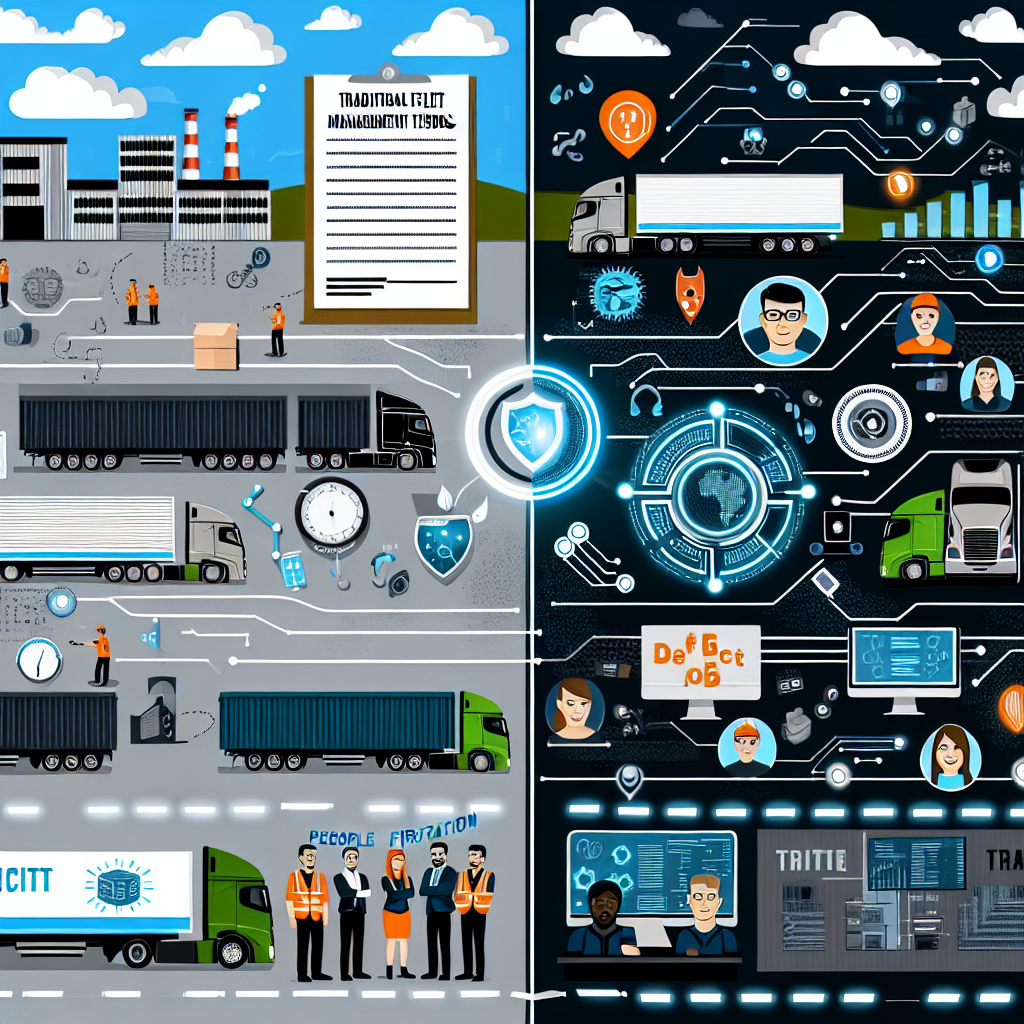In today’s fast-paced transportation landscape, the trucking industry stands at a pivotal crossroads, where investing in employee engagement in trucking must be harmonized with the essential practice of integrating technology. A compelling case study from Paper Transport, a Wisconsin-based carrier, illustrates this balance beautifully. They implemented a comprehensive technology integration strategy by deploying tablets for real-time access to crucial information, an online training platform, and an innovative driver scorecard app. These initiatives not only streamlined their operations but also engaged employees effectively, resulting in a reduced turnover rate and higher job satisfaction.
As technology transforms operations through automation and smart routing systems, fleet managers must prioritize people-first strategies that elevate employee engagement and foster a robust company culture. The mantra of Investing in People in Trucking isn’t just a catchy phrase; it represents a vital investment in the workforce that ultimately drives success. Recognizing that successful integration of advanced technologies relies on skilled and motivated personnel can redefine how fleets operate, leading to sustainability and growth during challenging times.

The Benefits of a People-First Approach in Trucking
Adopting a people-first approach in the trucking industry yields numerous advantages. These benefits enhance employee welfare and improve operational outcomes. Here are the key benefits:
Improved Employee Engagement
- Engaged employees are crucial for organizational success, especially in trucking where safety and customer service are paramount.
- Companies with highly engaged workforces see a 17% increase in productivity.
- Engaged drivers are safer, resulting in a 70% decrease in safety incidents.
- This engagement leads to lower turnover rates, helping companies retain experienced drivers who enhance the organization’s reputation.
Reduced Absenteeism
- People-first strategies, like Employee Assistance Programs (EAPs), can significantly reduce absenteeism.
- A case study showed a mid-sized company cut absenteeism from 8% to 3.5% by introducing wellness programs and training supervisors for a supportive environment.
- Reducing absenteeism not only boosts productivity but also lessens the workload on remaining employees.
Enhanced Training Outcomes
- Investing in comprehensive training is vital to a people-first approach. This focus on employee development improves service quality and makes employees feel valued.
- Programs using technology, like AI-driven training systems, have shown promising results in engagement and effectiveness.
- Companies that prioritize training have reported up to a 40% decrease in quality incidents, demonstrating the impact of skilled employees on service delivery.
Conclusion
Adopting a people-first strategy improves the work environment and drives higher employee engagement, reduced absenteeism, and better service quality. Investing in people lays the foundation for sustainable success in the trucking industry.
Insights from Industry Leaders
To further emphasize the importance of a people-first approach in integrating technology within fleet management, insights from industry leaders can be invaluable. Though specific quotes from David Kelly, Kristen Fess, Jason Belgrave, and Gary Vandenheuvel were not sourced, sentiments from various leaders in the field align similarly:
- David Kelly suggests, “You have to look after the entire customer base,” underscoring that employee welfare directly impacts customer satisfaction and service quality.
- Kristen Fess remarks, “Agility is built through repeated exposure to new experiences,” highlighting the necessity of human adaptability alongside any technological shift.
- Jason Belgrave notes, “The first instinct is to see automation as a way to cut costs, but it’s really about redeploying people into higher-value work,” pointing to the need for human expertise in maximizing technology’s potential.
- Gary Vandenheuvel adds, “We can’t just say, ‘Do what we did.’ We have to adapt,” reinforcing the idea that adaptation and responsiveness must involve the human element.
Moreover, industry discussions reveal broader concerns around the balance between technology and the human touch. For instance, Mel Pawlisz of Four Seasons Heating & A/C reflected on the risk of losing personal relationships, stating, “We’re losing the personal touch by not getting to know the people we deal with and how they work.” This highlights the essential nature of interpersonal connections in an increasingly automated environment.
Additionally, companies like Schneider Logistics invest in technology not only for efficiency but to improve drivers’ work experience, showing that technology and humanity can coexist harmoniously when handled correctly. As Lakshmi Moorthy from Arval points out, the role of professional fleet managers is critical in navigating the choices dictated by data and technology, ensuring that human factors remain central to operations.
Overall, adopting a people-first strategy amidst technological advancement is a crucial aspect of modern fleet management that industry leaders consistently promote.
User Adoption of Digital Innovations and People-Centric Strategies in Fleet Management
In the evolving landscape of fleet management, companies have increasingly recognized the necessity of merging digital innovations with people-centric strategies to boost training and employee engagement. The statistics indicate a strong trend toward integrating digital innovations, emphasizing the importance of both training and onboarding processes to foster employee engagement.
The adoption of safety protocol training has soared, with 70% of fleet companies enhancing their upskilling efforts to ensure compliance with new regulatory standards. Notably, 60% have embraced virtual reality training, showcasing a shift towards more immersive learning experiences. Furthermore, digital onboarding initiatives have transformed the new hire experience; 69% of companies report improvements, with reduced orientation times averaging 40%. These changes lead to significant productivity boosts—organizations utilizing technology-enabled onboarding see a 54% increase in new hire effectiveness. Continuous learning opportunities are also crucial, with 82% of fleet firms noting higher employee engagement when such avenues are provided. Collectively, these statistics reflect an industry that prioritizes innovative training and onboarding strategies, underscoring the vital role of employee-centric approaches in driving organizational success.
Comparison Table: Digital Tools vs. People-First Strategies in Fleet Management
| Category | Digital Tools | People-First Strategies |
|---|---|---|
| Costs | Often high initial investment, with ongoing maintenance costs | Generally lower costs, focusing on development and well-being |
| Effectiveness | Automation improves efficiency and data management | Enhances team collaboration and adaptability |
| Employee Satisfaction | May lead to dissatisfaction if technology replaces human interaction | Boosts morale, engagement, and loyalty |
This table highlights the key differences between relying solely on digital tools and incorporating people-first strategies. While digital tools can drive efficiency, the benefits of investing in people often translate into higher employee satisfaction and long-term success.
Automation’s Impact on Training in Fleet Management
The integration of automation tools such as artificial intelligence (AI) and virtual reality (VR) has dramatically reshaped the training landscape in fleet management. Previously, training programs required weeks, if not months, to develop new drivers, but these advanced technologies have reduced this timeline to mere hours.
Artificial Intelligence in Training
AI plays a crucial role in streamlining training by providing data-driven insights that enhance decision-making in the classroom and behind the wheel. By analyzing driver performance data, AI systems can personalize training modules, helping trainees focus on areas where they need improvement. For instance, organizations utilizing AI in their training programs have observed a significant reduction in operational costs, averaging a 25% decrease, by optimizing training efficiencies and ensuring that drivers are better equipped to handle real-world scenarios.
Moreover, with predictive maintenance becoming a reality, AI has enabled fleets to foresee mechanical failures before they happen, further contributing to a safer training environment. A report indicated a 25% reduction in accident rates in fleets with AI-assisted safety systems, emphasizing the importance of incorporating this technology into driver training.
Virtual Reality’s Transformative Role
Virtual reality technology has revolutionized how drivers receive training. By immersing trainees in virtual environments, they can practice skills in realistic scenarios without the inherent risks associated with real-world driving. Studies have shown that VR training results in a 76% increase in training success rates and a 45% faster transition from classroom learning to being road-ready. Additionally, after implementing VR training, companies have witnessed a dramatic 68% decrease in accidents.
Case Study: TransAmerica Logistics
As a prime example of automation in action, TransAmerica Logistics employed AI technology for its mobile inspections, which yielded remarkable outcomes:
- Training Time Reduction: They cut inspection times from 45 minutes to just 6 minutes per vehicle.
- Cost Savings: This shift resulted in annual savings of approximately $2.4 million through reduced downtime and maintenance costs.
- Enhanced Compliance: The company observed zero out-of-service violations over an 18-month span, showcasing how effective training and inspection processes can improve overall safety and compliance.
Conclusion
The adoption of automation tools like AI and VR in fleet management has not only optimized training times but also enhanced the overall quality of driver education. By investing in these technologies, fleet management companies can ensure that their workforce is healthier, safer, and more skilled, ultimately fostering long-term success in the competitive trucking industry.
Sources:

In conclusion, as the fleet management industry navigates the rapidly evolving landscape of technology, it is essential to recognize that the most effective strategies will be those that balance digital innovation with a committed investment in people. The insights shared highlight that while automation and smart tools streamline operations and enhance efficiency, the true backbone of any successful fleet lies within its workforce.
Emphasizing employee engagement, comprehensive training, and a supportive culture fosters not only job satisfaction but also operational excellence. Looking ahead, as we continue to blend these approaches, there is immense potential for growth, adaptability, and resilience in facing future challenges. The hope is to see an industry evolution where technology and human insight coexist harmoniously, ultimately driving the success of fleets and enriching the lives of those who operate them.
By prioritizing both people and technology, we can pave the way for innovative solutions that not only tackle current demands but also prepare businesses for the future.
Balancing Digital Innovation with People-First Strategies in Fleet Management
In today’s fast-paced transportation landscape, the trucking industry stands at a pivotal crossroads, where investing in employee engagement in trucking must be harmonized with the essential practice of integrating technology. As technology transforms operations through automation and smart routing systems, it becomes paramount for fleet managers to prioritize people-first strategies that elevate employee engagement and foster a robust company culture. The mantra of ‘Investing in People in Trucking’ isn’t just a catchy phrase; it represents a vital investment in the workforce that ultimately drives success. Recognizing that successful integration of advanced technologies relies on skilled and motivated personnel can redefine how fleets operate, leading to sustainability and growth during challenging times.
The Benefits of a People-First Approach in Trucking
Adopting a people-first approach in the trucking industry yields numerous advantages that significantly enhance both employee welfare and operational outcomes. Here are the key benefits:
Improved Employee Engagement
- Engaged employees are crucial for organizational success, especially in trucking where safety and customer service are paramount. Research indicates that companies with highly engaged workforces see a 17% increase in productivity and enjoy 21% higher profitability [transforce.com], [approvedforwarders.com].
- Engaged drivers are safer, resulting in a 70% decrease in safety incidents. This engagement leads to lower turnover rates, helping companies retain experienced drivers who enhance the organization’s reputation.
Reduced Absenteeism
- People-first strategies, like Employee Assistance Programs (EAPs), can significantly reduce absenteeism. A mid-sized company cut absenteeism from 8% to 3.5% by introducing wellness programs [iGrowFit].
- Reducing absenteeism boosts productivity and lessens the workload on remaining employees.
Enhanced Training Outcomes
- Investing in comprehensive training is vital to a people-first approach. This focus on employee development improves service quality and makes employees feel valued. Programs using technology, such as AI-driven training systems, have shown promising results in engagement and effectiveness, with companies reporting a decrease in quality incidents by up to 40% [movex.group].
Conclusion
Adopting a people-first strategy improves the work environment and drives higher employee engagement, reduced absenteeism, and better service quality. Investing in people lays the foundation for sustainable success in the trucking industry.
Insights from Industry Leaders
To further emphasize the importance of a people-first approach in integrating technology within fleet management, insights from industry leaders can be invaluable. Industry discussions reveal broader concerns around the balance between technology and the human touch.
Moreover, companies like Schneider Logistics invest in technology not only for efficiency but to improve drivers’ work experience, showing that technology and humanity can coexist harmoniously when handled correctly.
Overall, adopting a people-first strategy amid technological advancement is a crucial aspect of modern fleet management that industry leaders consistently promote.
User Adoption of Digital Innovations and People-Centric Strategies in Fleet Management
The statistics indicate a strong trend toward integrating digital innovations, emphasizing the importance of both training and onboarding processes to foster employee engagement. For example, regarding safety protocol training, 70% of fleet companies are enhancing their upskilling efforts. Notably, 60% have embraced virtual reality training, showcasing a shift towards immersive learning experiences. Continuous learning opportunities significantly enhance engagement, with 82% noting higher employee engagement when such avenues are provided.
Comparison Table: Digital Tools vs. People-First Strategies in Fleet Management
| Category | Digital Tools | People-First Strategies |
|---|---|---|
| Costs | Often high initial investment, with ongoing maintenance costs | Generally lower costs, focusing on development and well-being |
| Effectiveness | Automation improves efficiency and data management | Enhances team collaboration and adaptability |
| Employee Satisfaction | May lead to dissatisfaction if technology replaces human interaction | Boosts morale, engagement, and loyalty |
This table highlights the key differences between relying solely on digital tools and incorporating people-first strategies. While digital tools can drive efficiency, the benefits of investing in people often translate into higher employee satisfaction and long-term success.
Automation’s Impact on Training in Fleet Management
The integration of automation tools such as artificial intelligence (AI) has dramatically reshaped the training landscape in fleet management. Previously, training programs required weeks to develop new drivers, but these advanced technologies have reduced this timeline to mere hours.
AI systems can personalize training modules based on performance data, helping trainees focus on improvement areas.
Case Study: TransAmerica Logistics
As a prime example of automation in action, TransAmerica Logistics employed AI technology for its mobile inspections, yielding remarkable outcomes:
- Training Time Reduction: Inspection times reduced from 45 minutes to 6 minutes per vehicle.
- Cost Savings: Resulted in annual savings of approximately $2.4 million.
- Enhanced Compliance: Zero out-of-service violations over 18 months.
The adoption of automation tools like AI in fleet management has not only optimized training times but also enhanced the overall quality of driver education.
The Impact of Technology on Driver Wellbeing
The integration of technology in the trucking industry has profound implications on driver wellbeing. Enterprises are increasingly adopting AI and machine learning to optimize routing and workload management, enhancing job satisfaction.
With dedicated strategies to enhance communication and work conditions, organizations can significantly improve driver morale and retention rates [movex.group].
By intertwining technology with a people-first mindset, fleet management can cultivate an environment where drivers thrive, ultimately benefiting the entire organization.
Sources:
The Impact of Technology on Driver Wellbeing
The integration of technology in the trucking industry has had profound implications on driver wellbeing. Recent studies indicate that 75% of truck drivers report their job to be mentally and physically stressful, underscoring the critical need for innovative solutions to enhance their working conditions [DAT]. Advances in technology aim not only to improve efficiency but also to bolster the mental health of drivers.
Mental Health and Job Satisfaction
Research suggests that the use of digital tools can reduce stress levels among drivers by facilitating better communication, enhancing route planning, and providing real-time updates on traffic conditions. Technological tools such as fatigue monitoring systems and AI-driven analytics can help identify when a driver needs a break, ultimately preventing burnout. A Geotab survey revealed that 91% of European commercial drivers believe their work-related stress negatively impacts their driving [PR Newswire]. By addressing these stressors, companies can implement supportive measures that enhance driver productivity and satisfaction.
Safety Enhancements
Technology facilitates safety improvements through advanced driver-assistance systems (ADAS), which include features like lane departure warnings and automated braking systems. These innovations help mitigate accidents caused by human error, contributing positively to the driver’s mental wellbeing. A focus on enhanced safety not only protects drivers but also reduces the anxiety associated with driving in adverse conditions.
Real Stories from Truck Drivers
Drivers have reported significant improvements in their work experiences attributed to new technologies. For instance, one long-haul driver highlighted that the introduction of GPS tracking helped him navigate more efficiently, resulting in less stress associated with getting lost and late deliveries. Another driver mentioned that wearables tracking his health metrics ensured timely breaks, which improved both his physical and mental focus on the road. These narratives reflect the potential of technology not only to improve operational efficiencies but also to enhance individual driver experiences.
Future Trends in Technology and Impact on People Strategies
As we look forward, several technological trends are poised to further improve the trucking industry, with a strong emphasis on driver wellbeing. These innovations will shape organizational strategies in the years to come:
- Enhanced AI Capabilities: Organizations are increasingly adopting AI and machine learning to optimize routing and workload management. This technology helps alleviate the stress of unpredictable schedules and traffic conditions, enhancing job satisfaction and retention rates.
- Electric Vehicles and Sustainability: The shift toward electric trucks is not only environmentally friendly but also comes with reduced noise pollution and operational costs. Drivers often find these vehicles easier to operate, which improves their overall working conditions and reduces stress levels associated with maintenance and refueling.
- Telematics Integration: Advanced telematics systems provide fleet managers with invaluable data on driver performance while offering drivers insights into their behaviors. This real-time feedback loop enables targeted interventions, such as personalized training and support, leading to healthier job satisfaction and lower stress levels.
- Focus on Remote Support Systems: As remote work continues to gain traction, hybrid working models that blend office and on-road support may evolve. This flexibility can boost morale and reduce the pressure of prolonged time away from home for drivers, fostering broader employee engagement.
- Blockchain Innovations: Implementing blockchain in logistics can streamline supply chain processes, reduce paperwork, and enhance transparency. Such improvements not only cut down on administrative stress for drivers but also foster a culture of trust within the organization, which is vital for job satisfaction.
Overall, the continuous integration of technology in trucking is set to redefine not just operational practices but also the physical and mental wellbeing of drivers. Future advancements promise to enhance job security, promote healthier working conditions, and ultimately lead to a more satisfied workforce.


